

Info here:
The April 1942 air attack on Japan, launched from the aircraft carrier Hornet and led by Lieutenant Colonel James H. Doolittle, was the most daring operation yet undertaken by the United States in the young Pacific War. Though conceived as a diversion that would also boost American and allied morale, the raid generated strategic benefits that far outweighed its limited goals.
The raid had its roots in a chance observation that it was possible to launch Army twin-engined bombers from an aircraft carrier, making feasible an early air attack on Japan. Appraised of the idea in January 1942, U.S. Fleet commander Admiral Ernest J. King and Air Forces leader General Henry H. Arnold greeted it with enthusiasm. Arnold assigned the technically-astute Doolittle to organize and lead a suitable air group. The modern, but relatively well-tested B-25B "Mitchell" medium bomber was selected as the delivery vehicle and tests showed that it could fly off a carrier with a useful bomb load and enough fuel to hit Japan and continue on to airfields in China.
Gathering volunteer air crews for an unspecified, but admittedly dangerous mission, Doolittle embarked on a vigourous program of special training for his men and modifications to their planes. The new carrier Hornet was sent to the Pacific to undertake the Navy's part of the mission. So secret was the operation that her Commanding Officer, Captain Marc A. Mitscher, had no idea of his ship's upcoming employment until shortly before sixteen B-25s were loaded on her flight deck. On 2 April 1942 Hornet put to sea and headed west across the vast Pacific.
 Images from here and here.
Images from here and here.

No comments:
Post a Comment